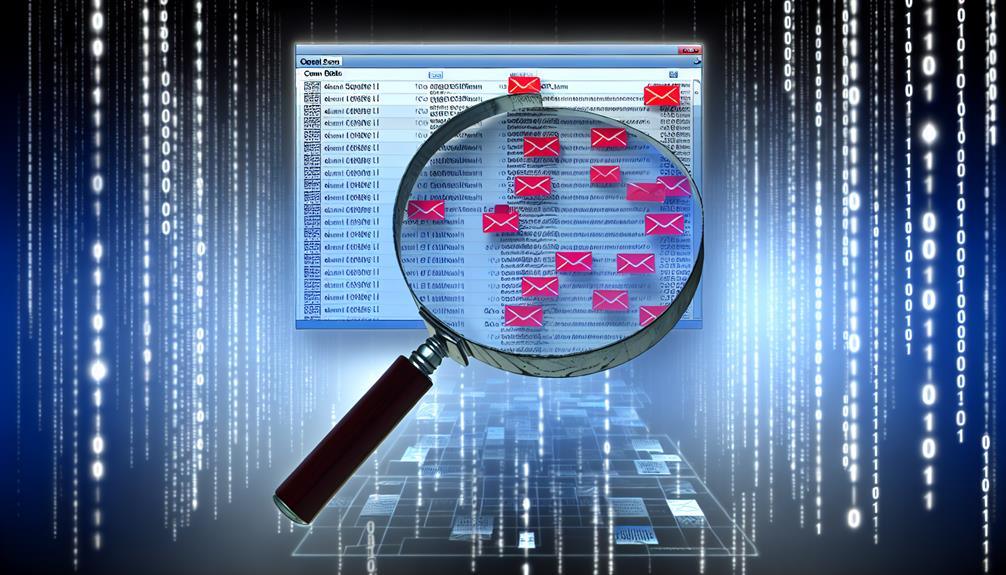When it comes to email deliverability, understanding domain spam checks is more important than you might think. You'll want to keep an eye on your domain's reputation and implement key authentication protocols to guarantee your emails land in inboxes rather than spam folders. Regular monitoring can help identify potential issues before they escalate. But what common misconceptions are out there that could impact your strategy? And how can you effectively manage your email lists to minimize spam risks? Let's explore these critical insights together.
Email Domain Spam Checks
An email domain spam checker evaluates whether your domain is on any spam blocklists and assesses its overall reputation.
Understanding how email domain spam affects your communications is vital for maintaining deliverability and engagement.
What is an Email Domain Spam Checker?
Evaluating the reputation of an email domain is essential for ensuring successful email delivery, and that's where an email domain spam checker comes into play. This tool assesses your domain's reputation to determine its likelihood of being marked as spam by inbox providers.
It analyzes various factors such as past sending behavior, domain authentication status, and whether your domain appears on spam blacklists.
By regularly using an email domain spam checker, you can identify potential deliverability issues before launching your email campaigns. High spam complaint rates, frequent hard bounces, and low engagement metrics can greatly harm your domain's reputation, so proactive checks are vital.
Maintaining a solid standing with these checkers enhances your email deliverability rates, ensuring that a larger percentage of your emails land in recipients' inboxes rather than their spam folders.
How Email Domain Spam Affects Your Communications
Maintaining a positive email domain reputation is important for effective communication, as it directly influences whether your messages reach their intended recipients. Low domain reputation scores can lead to a staggering 79.6% chance of your emails being diverted to spam folders, creating significant email deliverability issues.
With nearly 48% of all daily emails classified as spam, it's essential to make certain your domain remains clean. Your past interactions with recipients, including spam complaints and low engagement rates, can severely impact future inbox placement. This ongoing cycle can exacerbate deliverability problems.
Email service providers often scrutinize domains lacking proper authentication measures like SPF, DKIM, and DMARC, increasing the likelihood of spam classification. Regularly checking your domain reputation is critical. Monitor your email content and make sure it aligns with best practices to avoid triggering spam filters.
Additionally, keep an eye on bounce rates, as high rates can signal issues that may lead to spam reports. Finally, check for listings on spam blacklists; being on one can cause immediate drops in deliverability. Taking these steps helps you maintain effective communication and guarantees your messages land where they belong.
Importance of Checking Email Domain for Spam
Checking your email domain for spam is vital; nearly half of all emails sent daily end up classified as spam. This can greatly impact your deliverability rates. A poor domain reputation may cause only about 79.6% of your emails to reach intended inboxes, leading to considerable engagement loss.
Regularly utilizing spam check tools helps identify if your domain is on any blacklists, which can further hinder your email deliverability.
Maintaining a clean email list is essential; high bounce rates and spam complaints can damage your domain's reputation. If your emails frequently bounce or receive complaints, your domain may be flagged as spam, reducing your chances of successful communication.
Implementing domain authentication methods such as SPF, DKIM, and DMARC can enhance your domain's credibility, greatly lowering the likelihood of being marked as spam.
Common Misconceptions About Email Domain Spam Checks
Despite the significance of keeping your email domain in good standing, many people hold misconceptions about how spam checks work. For instance, some believe that conducting a spam check guarantees inbox placement. However, maintaining email deliverability requires ongoing management of your email reputation, engagement metrics, and consistent interaction with recipients.
Another common misconception is that all spam checks are identical. In reality, different tools assess various factors, including domain reputation, blacklist status, and email content quality.
Additionally, many users mistakenly think spam filters focus solely on content. In truth, they also consider sending history and domain authentication, which are crucial for your email's classification.
It's also a common error to assume that a single spam check is enough. Regular monitoring and testing are essential to uphold a healthy email sending reputation.
How to Check Email Domain Spam Score
To check your email domain's spam score, you can use various online tools designed to analyze domain reputation.
These tools evaluate metrics such as past interactions and engagement rates, helping you understand how your email practices impact deliverability.
Methods for Checking Email Domain Spam Score
Understanding your email domain's spam score is crucial for maintaining a strong sender reputation and guaranteeing successful email delivery. To effectively check your email domain spam score, start by utilizing tools that assess your sender reputation based on key factors like bounce rates, spam complaints, and engagement metrics.
Regularly monitor your domain's status on known spam blacklists, as being listed can severely impact your email deliverability.
Next, analyze engagement metrics, such as open rates and click-through rates. High engagement typically indicates a positive domain reputation, while low engagement may signal potential spam issues.
It's also essential to verify your domain is authenticated using SPF, DKIM, and DMARC. Proper email authentication not only improves your spam score but also helps prevent your emails from being marked as spam.
Lastly, conduct regular deliverability tests to evaluate how your emails perform across various email service providers (ESPs). This proactive approach helps identify any potential spam score issues before launching your campaigns, guaranteeing better outcomes for your email marketing efforts.
Using Online Tools for Spam Checks
Many businesses rely on online tools to check their email domain spam score, as these resources offer valuable insights into your sender reputation.
These tools evaluate various factors that can impact your email deliverability, such as bounce rates and spam complaints.
Here are some key benefits of using online spam check tools:
- Blacklist Monitoring: They assess if your domain or IP address is listed on any spam blacklists, which can severely affect deliverability.
- Content Analysis: Tools can analyze your email content for spam trigger words and phrases, helping you optimize your messaging.
- Engagement Metrics: Continuous monitoring provides insights into user engagement rates, which are vital for maintaining a positive reputation.
- Feedback Loops: Implementing feedback loops with email providers allows for real-time insights into spam reports, enabling proactive measures.
the Spam Score Metrics
To check if your domain is on a spam list, you'll want to use specialized tools that scan various blacklist databases.
These tools evaluate your domain's reputation based on factors like previous spam reports and sender behavior.
Regular checks can help you identify potential issues and improve your email deliverability.
How to Check if Domain is on Spam List?
Maintaining a strong email reputation is essential for effective communication, and checking if your domain is on a spam list is a key part of this process.
Use online tools to scan for blacklist entries, and monitor metrics like bounce rates and engagement rates.
Regularly check feedback loops with Internet Service Providers to confirm your sender reputation supports peak email deliverability.
Spam Email Domain Lists and Their Importance
Spam email domain lists play a key role in identifying and blocking sources of unwanted emails.
By understanding how to report spam domains and utilize tools like SpamAssassin, you can protect your inbox and improve your email campaigns.
Let's explore the significance of these lists and how they can enhance your overall email performance.
Overview of Spam Email Domain Lists
Email domain spam lists serve as significant tools for email service providers, helping to identify and mitigate the risks associated with domains that frequently distribute unwanted or harmful content.
By maintaining these lists, providers protect users from spam and enhance overall email deliverability.
Understanding the implications of these lists is important for anyone managing email campaigns. Here are four key points you should know:
- Impact on Sender Reputation: Being on a spam domain list can severely damage your sender reputation.
- Email Deliverability: Legitimate emails might end up in spam folders, reducing visibility and engagement.
- Engagement Metrics: Domains flagged as spam often experience lower open rates and increased bounce rates.
- Spam Classification: High spam complaints can lead to your domain's inclusion on these lists, making it essential to address underlying issues.
Regularly checking your domain against spam domain lists is crucial.
By doing so, you can proactively manage your domain reputation and facilitate better email deliverability for your campaigns.
Addressing the factors contributing to spam classification will help restore your standing and improve engagement metrics over time.
How to Report Spam Domain
Reporting spam domains is important for fostering a secure email environment. When you encounter unsolicited emails, promptly reporting the sending domain helps email service providers identify and block malicious senders. This action not only protects you but also aids in the creation of thorough spam domain lists, which are essential for tracking known spammers.
These lists are compiled from user reports and automated detection systems, greatly enhancing email deliverability for legitimate senders. By actively participating in reporting spam, you're contributing to a system that refines filtering algorithms and improves overall email security. Each report you submit helps organizations to combat phishing and fraudulent emails more effectively.
To report spam domains, you can typically use the reporting features provided by your email service provider. This may include marking emails as spam or forwarding them to designated abuse addresses.
Regularly consulting spam domain lists and staying informed on emerging threats empowers you to take proactive measures, ensuring safer online communication. Remember, your vigilance plays an important role in maintaining the integrity of the email ecosystem and enhancing the overall user experience.
Using SpamAssassin to Block Domains
In today's digital landscape, maintaining a secure inbox is essential for users, and one effective way to achieve this is by leveraging SpamAssassin's capabilities. By employing a scoring system, SpamAssassin evaluates incoming emails against various spam criteria, which helps you identify and block spam domains.
The system keeps an extensive list of known spam domains that's regularly updated, ensuring effective filtering against the latest threats. When domains frequently trigger spam complaints or are reported by users, they can be swiftly added to SpamAssassin's blocklists.
This proactive approach markedly reduces the likelihood of spam infiltrating your inbox. Implementing these domain blocklists not only enhances email security but also boosts overall email deliverability, allowing legitimate emails to pass through with minimal interference.
SpamAssassin's adaptability to user feedback makes it a crucial tool for maintaining email hygiene. By integrating seamlessly with various email systems, it continuously works to protect you from spam, ensuring a cleaner, safer email environment.
Utilizing SpamAssassin's capabilities effectively positions you to manage spam domains and enhance your email experience.
Example of a Common Spam Domain List
A common spam domain list serves as a vital resource for email marketers and organizations aiming to safeguard their communications.
These lists compile known domains associated with spam activities, helping you identify potential sources of deliverability issues. By regularly checking against these lists, you can prevent your emails from hitting spam traps, which could severely harm your sender reputation.
Here are some key benefits of utilizing spam domain lists:
- Prevent delivery failures: Avoid sending emails to known spam domains that lead to immediate rejections.
- Maintain a clean email list: Regular monitoring guarantees your email list remains free of harmful domains.
- Boost email performance: A clean list contributes to higher deliverability rates and better overall campaign results.
- Stay updated: Many email service providers offer regularly updated spam domain lists to reflect new threats.
Incorporating spam domain lists into your email strategy is essential. Ignoring them can lead to significant deliverability issues, affecting your sender reputation and overall email performance.
Practical Tips for Managing Email Domain Spam
To effectively manage email domain spam, you need to implement strategies that reduce risks and enhance your domain's reputation.
Regularly conducting mail domain spam checks and monitoring engagement metrics will help you identify areas for improvement.
Staying informed about future trends and best practices in email domain management is essential for maintaining deliverability and trust with your audience.
Strategies to Reduce Spam Risks
Effective strategies for reducing spam risks are essential for maintaining a healthy email domain reputation. Start by regularly cleaning your email lists to remove inactive or invalid addresses. High bounce rates can harm your IP address and domain reputation, making your emails more likely to be marked as spam.
Implement domain authentication protocols like SPF, DKIM, and DMARC to verify your identity as a sender. This helps improve email deliverability by reducing the risk of being classified as spam by mailbox providers.
Be mindful of your content; avoid using spam trigger words and excessive punctuation in your subject lines and emails. These can raise red flags with spam filters.
Additionally, monitor your email reputation using tools that check for listings on spam blacklists and provide insights into your sending practices. This proactive approach allows you to address potential issues before they escalate.
How to Conduct a Mail Domain Spam Check
Regularly checking your mail domain's status against spam blacklists is essential for maintaining email deliverability. Start by utilizing domain reputation monitoring tools to evaluate your domain's health. Focus on key metrics such as bounce rates and spam complaints, which can heavily influence your sender reputation.
Implement and maintain email authentication protocols like SPF, DKIM, and DMARC. These measures enhance your domain's credibility, reducing the chances of being marked as spam.
Additionally, regularly clean your email list to remove invalid or inactive addresses. A high bounce rate can negatively impact your reputation and increase spam classification risks.
Monitor feedback loops provided by email service providers (ESPs). These loops notify you about spam complaints, allowing you to address issues promptly and refine your email practices. Ignoring these complaints can lead to further deliverability challenges and damage your domain's standing.
Monitoring Click Domain Spam Activity
In the domain of email marketing, keeping a close eye on your domain's spam activity is vital for maintaining high deliverability rates. Regularly monitor your email domain to track spam complaints and blocklist status.
Remember, a single incident can greatly impact your sender reputation and overall email deliverability.
To reduce the risk of being flagged as spam, maintain a clean email list by regularly removing invalid addresses and inactive subscribers. This practice helps lower bounce rates, which can negatively affect your IP and domain standing.
Analyze engagement metrics like open and click-through rates; low engagement can indicate issues with your content or targeting, leading to increased spam classification.
Implement email authentication protocols such as SPF, DKIM, and DMARC to verify your identity as a sender, further preventing your emails from being marked as spam by recipient servers.
Lastly, be proactive in managing your domain's reputation. Review feedback from recipients regularly and adjust your sending practices accordingly.
Consistently high spam complaints can damage your domain's credibility over time, so addressing these issues promptly is essential for sustained success in your email marketing efforts.
Future Trends in Email Domain Spam Management
Maneuvering the evolving landscape of email domain spam management requires a proactive approach to maintain deliverability and sender reputation. As spam filters become more sophisticated, your focus should be on consistently engaging with your audience while adhering to best practices.
Regularly monitor your domain reputation and utilize feedback loops to identify potential spam issues early. This way, you can adjust your strategies proactively.
Implement robust authentication protocols like SPF, DKIM, and DMARC. These measures build trust with email service providers (ESPs) and markedly reduce the likelihood of your emails being marked as spam.
Additionally, the trend towards personalized emails in your campaigns can enhance engagement metrics, further improving your domain reputation and lowering spam classification.
With evolving regulations surrounding email marketing, staying compliant with the CAN-SPAM Act and GDPR is crucial. Non-compliance can harm your sending reputation and lead to penalties that affect your email deliverability.
Best Practices for Email Domain Management
Effective email domain management hinges on five key best practices that can greatly reduce spam issues and enhance deliverability.
By following these strategies, you'll strengthen your sender reputation and guarantee your emails reach their intended audience.
- Authenticate your email: Regularly use SPF, DKIM, and DMARC protocols to verify your sender identity, which builds trust with email service providers and reduces spam risk.
- Maintain a clean email list: Routinely remove inactive or invalid email addresses to avoid high bounce rates that can harm your sender reputation.
- Monitor engagement metrics: Keep an eye on open and click-through rates. Higher engagement levels indicate to email providers that your content is relevant, thereby improving deliverability.
- Utilize feedback loops: Address any spam complaints promptly to adjust your email campaigns and maintain a positive sender reputation.
Conduct regular spam checks and monitor your domain reputation through various tools to detect issues early.




